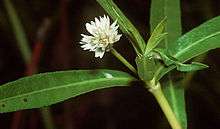Alternanthera philoxeroides
| Alternanthera philoxeroides | |
|---|---|
 | |
| Scientific classification | |
| Kingdom: | Plantae |
| (unranked): | Angiosperms |
| (unranked): | Eudicots |
| (unranked): | Core eudicots |
| Order: | Caryophyllales |
| Family: | Amaranthaceae |
| Genus: | Alternanthera |
| Species: | A. philoxeroides |
| Binomial name | |
| Alternanthera philoxeroides Griseb.[1] | |
Alternanthera philoxeroides, commonly known as alligator weed, is an emergent aquatic plant. It originated in Argentina in 1897,[2] but has spread to many parts of the world and is considered an invasive species in Australia, China, New Zealand, Sri Lanka,[3] Thailand, and the United States. The alligator weed's primary mode of transport is believed to be through ballast tanks on the side of traveling ships.[4]
Description
Though alligator weed tends to differ in appearance, the plant can often be identified by its fleshy stems and white flowers. These horizontal stems, which form dense mats on the surface of lakes and ponds, can grow up to 10 meters in length. Leaves are simple, elliptic, and have smooth margins. The plant flowers from December to April and usually grows around 13 mm in diameter and tend to be papery and ball-shaped. The weed's intricate root system does not have to establish in sediment or soil: many plants let their roots hang free in water to absorb nutrients. As an adaptive response to its environment, plants in water tend to have more hollow stems than its counterparts on land.[5]
Negative impacts
When alligator weed invades waterways, it can reduce water flow and quality by preventing light penetration and oxygenation of the water. It can also reduce water bird and fish activity and cause the death of fish and native plants. Alligator weed mats create a favorable habitat for breeding mosquitoes. Alligator weed is also difficult to control.
In Sri Lanka it is sometimes confused with the more traditionally accepted edible sessile joyweed.Alligator weed has been sometimes considered as an edible, but nowadays much shadow has been cast over this perception due to its ability to contain harmful toxins, including gradually accumulated heavy metal ions extracted from the polluted waterways and other similar stagnant habitats.
Methods of control
Insects have been released for the biological control of alligator weed. The most successful and widely used is Agasicles hygrophila commonly called the alligator weed flea beetle; it has been released for biocontrol in Australia, China, Thailand, New Zealand,[6] and the United States.[7] Amynothrips andersoni, the alligator weed thrips, and Vogtia malloi, the alligator weed stem borer, have also been released in the United States. A variety of chemicals have been shown to be effective in controlling the plant, the most useful of which include glyphosate, triclopyr, fluridone, imazamox, and imazapyr.[8]
References
- ↑ "Alternanthera philoxeroides information from NPGS/GRIN". www.ars-grin.gov. Retrieved 2008-08-09.
- ↑ "Louisiana Invasive Species". is.cbr.tulane.edu. Retrieved 2016-04-24.
- ↑ "Alligator weed is not Mukunuwenna". www.sundaytimes.lk. Retrieved 2016-05-18.
- ↑ Center, National Invasive Species Information. "Invasive Species: Aquatic Species - Alligatorweed (Alternanthera philoxeroides)". www.invasivespeciesinfo.gov. Retrieved 2016-04-24.
- ↑ "Alternanthera philoxeroides". www.sms.si.edu. Retrieved 2016-04-24.
- ↑ Stewart, C.A.; Chapman, R.B.; Frampton, C.M.A. (2000). "Growth of alligator weed (Alternanthera philoxeroides (Mart.) Griseb. (Amaranthaceae)) and population development of Agasicles hygrophila Selman & Vogt (Coleoptera: Chrysomelidae) in northern New Zealand.". Plant Protection Quarterly. 15 (3): 95–101. ISSN 0815-2195.
- ↑ Everitt, J.H.; Lonard, R.L.; Little, C.R. (2007). Weeds in South Texas and Northern Mexico. Lubbock: Texas Tech University Press. ISBN 0-89672-614-2.
- ↑ "Alligator Weed « AQUAPLANT". aquaplant.tamu.edu. Retrieved 2016-04-24.
External links
- University of Florida, Aquatic Weed Management Guide. Biological Control with Insects
- photograph, description and diagram from HerbiGuide
- Species Profile- Alligatorweed (Alternanthera philoxeroides), National Invasive Species Information Center, United States National Agricultural Library. Lists general information and resources for Alligatorweed.
- Alternanthera philoxeroides (Mart.) Griseb. Medicinal Plant Images Database (School of Chinese Medicine, Hong Kong Baptist University) (traditional Chinese) (English)